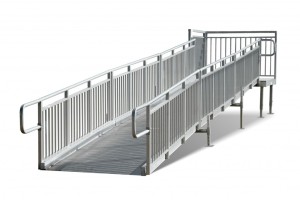The Americans with Disabilities Act has rules surrounding how well an ADA wheelchair ramp can work. Our staff at REDD Team is ready to help you create an ADA wheelchair ramp that fits all the necessary specifics you need to follow.
Slope
 The slope is the most essential specification to review for your ramp. The slope should be flat enough to allow wheelchair users to go up and down a space, but it shouldn’t take up too much space.
The slope is the most essential specification to review for your ramp. The slope should be flat enough to allow wheelchair users to go up and down a space, but it shouldn’t take up too much space.
The steepest possible slope you can get while meeting ADA standards is 1:12. This slope means the ramp rises 1 inch for every 12 inches of length.
A flatter slope at 1:8 or 1:10 can also work in some situations. But these slopes are best when you have enough room for them.
Width
Your ADA ramp must be at least 36 inches wide. The width is enough to allow a wheelchair to go through. You can use a wider size if you’re creating a ramp for curb use or providing an extended handrail setup.
Landings
You will require platform landings if your ramp is at least 30 feet long. A ramp will need a landing for every 30 feet of length. The landing works as a resting area, so adding a suitable landing in the middle will be essential.
A landing must be as wide as the rest of the ramp. For cases where different segments of the ramp have varying widths, the landing must be as wide as the widest ramp part. The landing must also be at least 60 inches long.
For instances where there’s a direction change in the ramp, the landing platform must be at least 60 inches long on all sides. The size is necessary for allowing the wheelchair to turn without obstruction.
Handrails
Handrails are necessary for protecting the people using the ramp. The handrails should be from 34 to 38 inches high, and there should be less than 4 inches of space between the balusters.
Additional curved extensions are necessary on the ends of the handrails. These extensions can be about 4 inches long.
The handrails must not interfere with the 36-inch width of the ramp. You can make your ramp slightly wider to offset any protrusions your rails might produce.
Guardrails
Guardrails are necessary for people who might assist others going on the ramp. The guardrail should be at least 42 inches high and directly over the handrail.
Edge Protection
An edge protection feature must also appear on the bottom part of the ramp. The protective point should be at least 2 inches high. The design should create a suitable barrier where a wheelchair will not be likely to slop off of the ramp. This feature isn’t intended to be a replacement for a handrail and guardrail setup, as it focuses mainly on providing a path for wheelchair use.
REDD Team will help you build a new wheelchair ramp that meets all ADA specifications. Let us know where you need your ramp, and we will create a design that works for you and complies with ADA laws. We use high-quality aluminum products in all our ramps, and we also manufacture everything in the United States. You can call us at (800) 648-3696 or visit our website to schedule an appointment for service.

